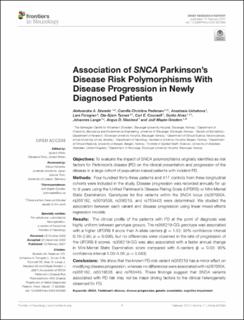| dc.contributor.author | Szwedo, Aleksandra A | |
| dc.contributor.author | Pedersen, Camilla C | |
| dc.contributor.author | Ushakova, Anastasia | |
| dc.contributor.author | Forsgren, Lars | |
| dc.contributor.author | Tysnes, Ole-Bjørn | |
| dc.contributor.author | Counsell, Carl E. | |
| dc.contributor.author | Alves, Guido Werner | |
| dc.contributor.author | Lange, Johannes | |
| dc.contributor.author | Macleod, Angus D. | |
| dc.contributor.author | Maple-Grødem, Jodi | |
| dc.date.accessioned | 2021-07-07T08:00:55Z | |
| dc.date.available | 2021-07-07T08:00:55Z | |
| dc.date.created | 2021-07-05T18:24:14Z | |
| dc.date.issued | 2021-02 | |
| dc.identifier.citation | Szwedo, A.A., Pedersen, C.C., Ushakova, A. et al. (2021) Association of SNCA Parkinson's Disease Risk Polymorphisms With Disease Progression in Newly Diagnosed Patients. Frontiers in Neurology, 11:620585 | en_US |
| dc.identifier.issn | 1664-2295 | |
| dc.identifier.uri | https://hdl.handle.net/11250/2763657 | |
| dc.description.abstract | Objectives: To evaluate the impact of SNCA polymorphisms originally identified as risk factors for Parkinson's disease (PD) on the clinical presentation and progression of the disease in a large cohort of population-based patients with incident PD.
Methods: Four hundred thirty-three patients and 417 controls from three longitudinal cohorts were included in the study. Disease progression was recorded annually for up to 9 years using the Unified Parkinson's Disease Rating Scale (UPDRS) or Mini-Mental State Examination. Genotypes for five variants within the SNCA locus (rs2870004, rs356182, rs5019538, rs356219, and rs763443) were determined. We studied the association between each variant and disease progression using linear mixed-effects regression models.
Results: The clinical profile of the patients with PD at the point of diagnosis was highly uniform between genotype groups. The rs356219-GG genotype was associated with a higher UPDRS II score than A-allele carriers (β = 1.52; 95% confidence interval 0.10–2.95; p = 0.036), but no differences were observed in the rate of progression of the UPDRS II scores. rs356219-GG was also associated with a faster annual change in Mini-Mental State Examination score compared with A-carriers (β = 0.03; 95% confidence interval 0.00–0.06; p = 0.043).
Conclusions: We show that the known PD-risk variant rs356219 has a minor effect on modifying disease progression, whereas no differences were associated with rs2870004, rs356182, rs5019538, and rs763443. These findings suggest that SNCA variants associated with PD risk may not be major driving factors to the clinical heterogeneity observed for PD. | en_US |
| dc.language.iso | eng | en_US |
| dc.publisher | Frontiers Media S.A | en_US |
| dc.rights | Navngivelse 4.0 Internasjonal | * |
| dc.rights.uri | http://creativecommons.org/licenses/by/4.0/deed.no | * |
| dc.subject | Parkinson | en_US |
| dc.title | Association of SNCA Parkinson's Disease Risk Polymorphisms With Disease Progression in Newly Diagnosed Patients | en_US |
| dc.type | Peer reviewed | en_US |
| dc.type | Journal article | en_US |
| dc.description.version | publishedVersion | en_US |
| dc.rights.holder | © 2021 Szwedo, Pedersen, Ushakova, Forsgren, Tysnes, Counsell, Alves, Lange, Macleod and Maple-Grødem. | en_US |
| dc.subject.nsi | VDP::Medisinske Fag: 700::Klinisk medisinske fag: 750::Nevrologi: 752 | en_US |
| dc.source.volume | 11 | en_US |
| dc.source.journal | Frontiers in Neurology | en_US |
| dc.identifier.doi | 10.3389/fneur.2020.620585 | |
| dc.identifier.cristin | 1920361 | |
| dc.source.articlenumber | 620585 | en_US |
| cristin.ispublished | true | |
| cristin.fulltext | original | |
| cristin.qualitycode | 1 | |

